Enhancing Wear Resistance and Mechanical Behaviors of AA7020 Alloys Using Hybrid Fe3O4-GNP Reinforcement
Abstract
:1. Introduction
2. Materials and Methods
2.1. Production Method of Composite Samples
2.2. Microstructure and Mechanical Analysis
3. Results and Discussion
3.1. Morphological Evolution of Composite Powders
3.2. Microstructural Analysis
3.3. Physical and Mechanical Properties Analysis
3.4. Tensile Strength Analysis
3.5. Wear Analysis
4. Conclusions
- The optimized parameters for ball grinding and sintering resulted in strong particle cohesion and densification, leading to the highest density (99.70%) in the AA7020 + 10% Fe3O4 + 0.5% GNP composite milled for 4 h, while the unreinforced AA7020 alloy exhibited the lowest density (98.8%);
- The presence of hard Fe3O4 particles and the load-bearing capability of GNPs, along with effective hot-pressing, resulted in a substantial increase in microhardness. The AA7020 + 10% Fe3O4 + 0.5% GNP composite milled for 8 h displayed the highest hardness (149 HBN) compared with the unreinforced alloy (109 HBN);
- The AA7020 + 10% Fe3O4 + 0.5% GNP composite milled for 4 h exhibited the highest tensile strength (292 MPa), representing a 28% increase compared with the unreinforced alloy (228 MPa);
- The incorporation of Fe3O4 and GNPs, combined with optimized milling and sintering, significantly reduced the friction coefficient. The unreinforced AA7020 alloy had the highest coefficient (0.45 µm), while the composite milled for 8 h showed the greatest reduction (0.33 µm, a 26% decrease);
- The hard Fe3O4 particles acted as barriers to wear, while the lubricating properties of GNPs reduced friction, resulting in a synergistic effect that significantly enhanced wear resistance;
- The AA7020 + 10% Fe3O4 + 0.5% GNP composite milled for 8 h demonstrated the lowest specific wear rate (7.86 × 10−7 mm3/Nm), while the unreinforced alloy demonstrated the highest (1.44 × 10−6 mm3/Nm).
Author Contributions
Funding
Data Availability Statement
Conflicts of Interest
References
- Yang, H.; Sha, J.; Zhao, D.; He, F.; Ma, Z.; He, C.; Shi, C.; Zhao, N. Defects Control of Aluminum Alloys and Their Composites Fabricated via Laser Powder Bed Fusion: A Review. J. Mater. Process. Technol. 2023, 319, 118064. [Google Scholar] [CrossRef]
- Stojanovic, B.; Bukvic, M.; Epler, I. Application of Aluminum and Aluminum Alloys in Engineering. Appl. Eng. Lett. 2018, 3, 52–62. [Google Scholar] [CrossRef]
- Hasan, M.S.; Wong, T.; Rohatgi, P.K.; Nosonovsky, M. Analysis of the Friction and Wear of Graphene Reinforced Aluminum Metal Matrix Composites Using Machine Learning Models. Tribol. Int. 2022, 170, 107527. [Google Scholar] [CrossRef]
- Saba, F.; Sun, H.; Fan, G.; Tan, Z.; Xiong, D.B.; Li, Z.; Li, Z. Strength-Ductility Synergy Induced by High-Density Stacking Faults in Aluminum Alloy Composites with Micro/Nano Hybrid Reinforcements. Compos. Part A Appl. Sci. Manuf. 2023, 173, 107700. [Google Scholar] [CrossRef]
- Saberi, Y.; Oveisi, H. Development of Novel Cellular Copper–Aluminum Composite Materials: The Advantage of Powder Metallurgy and Mechanical Milling Approach for Lighter Heat Exchanger. Mater. Chem. Phys. 2022, 279, 125742. [Google Scholar] [CrossRef]
- Zhu, P.; Zhang, L. Powder metallurgy aluminium alloys. Treatise Mater. Sci. Technol. 1994, 31, 323–364. [Google Scholar] [CrossRef]
- Gökmeşe, H.; Bülbül, Ş. Production of AA 2014 Matrix Wollostanite/Wood Ash Solid Waste Particle Reinforced Hybrid Composite with Powder Metallurgy and Investigation of Its Structural Properties. JOM 2024, 76, 1294–1305. [Google Scholar] [CrossRef]
- Kumar, A.; Rana, R.S.; Purohit, R.; Saxena, K.K.; Xu, J.; Malik, V. Metallographic Study and Sliding Wear Optimization of Nano Si3N4 Reinforced High-Strength Al Metal Matrix Composites. Lubricants 2022, 10, 202. [Google Scholar] [CrossRef]
- Bandyopadhyay, A.; Traxel, K.D.; Lang, M.; Juhasz, M.; Eliaz, N.; Bose, S. Alloy Design via Additive Manufacturing: Advantages, Challenges, Applications and Perspectives. Mater. Today 2022, 52, 207–224. [Google Scholar] [CrossRef]
- Yang, Y.; Yan, D.; Dong, Y.; Wang, L.; Chen, X.; Zhang, J.; He, J.; Li, X. In Situ Nanostructured Ceramic Matrix Composite Coating Prepared by Reactive Plasma Spraying Micro-Sized Al-Fe2O3 Composite Powders. J. Alloys Compd. 2011, 509, L90–L94. [Google Scholar] [CrossRef]
- Ardalanniya, A.; Nourouzi, S.; Jamshidi Aval, H. Effects of Multipass Additive Friction Stir Processing on Microstructure and Mechanical Properties of Al-Zn-Cup/Al-Zn Laminated Composites. JOM 2021, 73, 2844–2858. [Google Scholar] [CrossRef]
- Çelebi, M.; Çanakçi, A.; Güler, O.; Akgül, B.; Karabacak, A.H. Study on Effect of Milling Time on the Mechanical and Wear Properties of the ZA40-B4C-Graphene Hybrid Nanocomposites Fabricated by Vacuum Hot-Pressing. JOM 2023, 75, 3935–3950. [Google Scholar] [CrossRef]
- Şahingöz, B.; Karakoç, H.; Çıtak, R. Production of AA6061/TiB2/B4C/GNP hybrid surface composites processed by friction stir processing (FSP) and ınvestigation of mechanical properties. Gazi Univ. J. Sci. Part C Des. Technol. 2024, 12, 405–426. [Google Scholar] [CrossRef]
- Sadeghi, B.; Cavaliere, P.; Sadeghian, B. Enhancing Strength and Toughness of Aluminum Laminated Composites through Hybrid Reinforcement Using Dispersion Engineering. J. Compos. Sci. 2023, 7, 332. [Google Scholar] [CrossRef]
- Şap, S. Understanding the Machinability and Energy Consumption of Al-Based Hybrid Composites under Sustainable Conditions. Lubricants 2023, 11, 111. [Google Scholar] [CrossRef]
- Çinici, H.; Karakoç, H.; Şahin, Ö.; Ovalı, İ. Investigation of Microstructure, Mechanical, and Tribological Properties of SiC/h-BN/Gr Hybrid Reinforced Al6061 Matrix Composites Produced by Hot Extrusion Method. Diam. Relat. Mater. 2023, 136, 110028. [Google Scholar] [CrossRef]
- Karakoc, H.; Ovalı, İ.; Dundar, S.; Çıtak, R. Wear and Mechanical Properties of Al6061/SiC/B4C Hybrid Composites Produced with Powder Metallurgy. J. Mater. Res. Technol. 2019, 8, 5348–5361. [Google Scholar] [CrossRef]
- Ghandourah, E.; Ahmadian, H.; Zhou, T.; Sadoun, A.M.; Fathy, A.; Atif, M.; Senthil Kumar, A.; Weijia, G. Comprehensive Investigation of the Impact of Milling Time on Microstructural Evolution and Tribological Properties in Mg-Ti-SiC Hybrid Composites. Mater. Today Commun. 2024, 38, 107835. [Google Scholar] [CrossRef]
- Ames, W.; Alpas, A.T. Wear Mechanisms in Hybrid Composites of Graphite-20 Pct SiC in A356 Aluminum Alloy (Al-7 Pct Si-0.3 Pct Mg). Metall. Mater. Trans. A 1995, 26, 85–98. [Google Scholar] [CrossRef]
- Rashad, M.; Pan, F.; Hu, H.; Asif, M.; Hussain, S.; She, J. Enhanced Tensile Properties of Magnesium Composites Reinforced with Graphene Nanoplatelets. Mater. Sci. Eng. A 2015, 630, 36–44. [Google Scholar] [CrossRef]
- Kavimani, V.; Prakash, K.S.; Thankachan, T. Experimental Investigations on Wear and Friction Behaviour of SiC@r-GO Reinforced Mg Matrix Composites Produced through Solvent-Based Powder Metallurgy. Compos. Part B Eng. 2019, 162, 508–521. [Google Scholar] [CrossRef]
- Tasci, U.; Yilmaz, T.A.; Bostan, B. Investigation of Microstructure, Wear and Transverse Rupture Strength of WE43/Nano B4C Composites Produced by Powder Metallurgy Method. Tribol. Int. 2023, 180, 108231. [Google Scholar] [CrossRef]
- A, S.; Subramanya, R.; Basavaraj, Y. Tensile Hardness and Wear Properties of Iron Oxide (Fe3O4) Reinforced Aluminium 7075 Metal Matrix Composites. Adv. Mater. Process. Technol. 2022, 8, 4598–4612. [Google Scholar] [CrossRef]
- Ashrafi, N.; Hanim, M.A.A.; Sarraf, M.; Sulaiman, S.; Hong, T.S. Microstructural, Tribology and Corrosion Properties of Optimized Fe3O4-Sic Reinforced Aluminum Matrix Hybrid Nano Filler Composite Fabricated through Powder Metallurgy Method. Materials 2020, 13, 4090. [Google Scholar] [CrossRef] [PubMed]
- Lin, F.; Ren, M.; Wu, H.; Lu, Y.; Huo, M.; Yang, M.; Chen, Z.; Jiang, Z. Fabrication of TiC-Graphene Dual-Reinforced Self-Lubricating Al Matrix Hybrid Nanocomposites with Superior Mechanical and Tribological Properties. Tribol. Int. 2022, 171, 107535. [Google Scholar] [CrossRef]
- Khan, M.; Din, R.U.; Basit, M.A.; Wadood, A.; Husain, S.W.; Akhtar, S.; Aune, R.E. Study of Microstructure and Mechanical Behaviour of Aluminium Alloy Hybrid Composite with Boron Carbide and Graphene Nanoplatelets. Mater. Chem. Phys. 2021, 271, 124936. [Google Scholar] [CrossRef]
- Wang, Y.; Li, J.; Guan, B.; Tang, B.; Luo, H.; Lu, Y.; Yu, H.; He, W.; Chen, X.; Zheng, K. Microstructure and mechanical properties of hybrid graphene nanoplatelets/titanium particles reinforced AZ91 laminated composite. Mater. Sci. Eng. A 2022, 856, 144017. [Google Scholar] [CrossRef]
- Şenel, M.C.; Gürbüz, M.; Koç, E. Mechanical and Tribological Behaviours of Aluminium Matrix Composites Reinforced by Graphene Nanoplatelets. Mater. Sci. Technol. 2018, 34, 1980–1989. [Google Scholar] [CrossRef]
- Srivyas, P.D.; Gupta, A.; Medhi, T.; Arumugam, S.; Kumar, D.; Mohan, S. Corrosion and Tribo-Investigations on Alumina–Graphene-Doped Hybrid Aluminium Composites. Trans. Indian Inst. Met. 2023, 76, 3281–3291. [Google Scholar] [CrossRef]
- Tabandeh-Khorshid, M.; Ferguson, J.B.; Schultz, B.F.; Kim, C.S.; Cho, K.; Rohatgi, P.K. Strengthening mechanisms of graphene-and Al2O3-reinforced aluminum nanocomposites synthesized by room temperature milling. Mater. Des. 2016, 92, 79–87. [Google Scholar] [CrossRef]
- Göçer, A.; Nair, F.; Karamış, M.B. Mechanical and Micro structural Characterization of Al-Al/B4C Laminated Composites Depending on Manufacturing Parameters. In IOP Conference Series: Materials Science and Engineering; IOP Publishing: Bristol, UK, 2018; Volume 295, p. 012043. [Google Scholar]
- ASTM E10-23; Standard Test Method for Brinell Hardness of Metallic Materials. ASTM International: West Conshohocken, PA, USA, 2023. [CrossRef]
- ASTM G99-23; Standard Test Method for Wear and Friction Testing with a Pin-on-Disk or Ball-on-Disk Apparatus. ASTM International: West Conshohocken, PA, USA, 2023. [CrossRef]
- Zhang, H.; Xu, C.; Xiao, W.; Ameyama, K.; Ma, C. Enhanced Mechanical Properties of Al5083 Alloy with Graphene Nanoplates Prepared by Ball Milling and Hot Extrusion. Mater. Sci. Eng. A 2016, 658, 8–15. [Google Scholar] [CrossRef]
- Kaya, N.; Çetinkaya, C.; Karakoç, H.; Ada, H. Effect of Process Parameters of Al5083/SiC Surface Composites Fabricated by FSP on Microstructure, Mechanical Properties and Wear Behaviors. Mater. Chem. Phys. 2024, 315, 128991. [Google Scholar] [CrossRef]
- Zheng, Z.; Zhang, X.X.; Li, J.C.; Geng, L. High-Content Graphene Nanoplatelet Reinforced Aluminum Composites Produced by Ball Milling and Hot Extrusion. Sci. China Technol. Sci. 2020, 63, 1426–1435. [Google Scholar] [CrossRef]
- Thankachan, T.; Prakash, K.S.; Kavimani, V. Investigating the Effects of Hybrid Reinforcement Particles on the Microstructural, Mechanical and Tribological Properties of Friction Stir Processed Copper Surface Composites. Compos. Part B Eng. 2019, 174, 107057. [Google Scholar] [CrossRef]
- Wakhi Anuar, N.F.B.; Salleh, M.S.; Omar, M.Z.; Zamri, W.F.H.W.; Md Ali, A.; Samat, S. Wear Properties of Graphene-Reinforced Aluminium Metal Matrix Composite: A Review. Rev. Adv. Mater. Sci. 2023, 62, 20220326. [Google Scholar] [CrossRef]
- Zhang, S.; Chen, Z.; Wei, P.; Liu, W.; Zou, Y.; Lei, Y.; Yao, S.; Zhang, S.; Lu, B.; Zhang, L. Wear properties of graphene/zirconia biphase nano-reinforced aluminium matrix composites prepared by SLM. Mater. Today Commun. 2022, 30, 103009. [Google Scholar] [CrossRef]
- Omrani, E.; Moghadam, A.D.; Kasar, A.K.; Rohatgi, P.; Menezes, P.L. Tribological Performance of Graphite Nanoplatelets Reinforced Al and Al/Al2O3 Self-Lubricating Composites. Materials 2021, 14, 1183. [Google Scholar] [CrossRef] [PubMed]
- Zeng, X.; Yu, J.; Fu, D.; Zhang, H.; Teng, J. Wear Characteristics of Hybrid Aluminum-Matrix Composites Reinforced with Well-Dispersed Reduced Graphene Oxide Nanosheets and Silicon Carbide Particulates. Vacuum 2018, 155, 364–375. [Google Scholar] [CrossRef]
- Sharma, A.; Narsimhachary, D.; Sharma, V.M.; Sahoo, B.; Paul, J. Surface Modification of Al6061-SiC Surface Composite through Impregnation of Graphene, Graphite & Carbon Nanotubes via FSP: A Tribological Study. Surf. Coatings Technol. 2019, 368, 175–191. [Google Scholar] [CrossRef]
- Abbas Shafqat, Q.; Rafi-Ud-Din; Shahzad, M.; Khan, M.; Mehmood, S.; Syed, W.A.; Basit, A.; Mehboob, N.; Ali, T. Mechanical, Tribological, and Electrochemical Behavior of Hybrid Aluminum Matrix Composite Containing Boron Carbide (B4C) and Graphene Nanoplatelets. J. Mater. Res. 2019, 34, 3116–3129. [Google Scholar] [CrossRef]
- El-Garhy, G.; El Mahallawy, N.; Shoukry, M.K. Effect of grain refining by cyclic extrusion compression (CEC) of Al-6061 and Al-6061/SiC on wear behavior. J. Mater. Res. Technol. 2021, 12, 1886–1897. [Google Scholar] [CrossRef]
- Zhang, J.; Yang, S.; Chen, Z.; Wu, H.; Zhao, J.; Jiang, Z. Graphene Encapsulated SiC Nanoparticles as Tribology-Favoured Nanofillers in Aluminium Composite. Compos. Part B Eng. 2019, 162, 445–453. [Google Scholar] [CrossRef]
- Zheng, K.; Du, X.; Qi, H.; Zhao, T.; Liu, F.; Sun, B. Sliding-Wear Behavior of Aluminum-Matrix Composites Reinforced with Graphene and SiC Nanoparticles. Mater. Tehnol. 2020, 54, 41–48. [Google Scholar] [CrossRef]
- Samad, A.; Arif, S.; Ansari, S.; Muaz, M.; Mohsin, M.; Ulla Khan, A.; Khan, M.E.; Bashiri, A.H.; Zakri, W.; Ali, W. Machine Learning Enabled Prediction of Tribological Properties of Cu-TiC-GNP Nanocomposites Synthesized by Electric Resistance Sintering: A Comparison with RSM. J. Mater. Res. Technol. 2024, 28, 2290–2312. [Google Scholar] [CrossRef]
- Pillari, L.K.; Lessoway, K.; Bichler, L. Reciprocating Dry Sliding Friction and Wear Behavior of B319 Aluminum Alloy-Graphene Composites. Tribol. Int. 2024, 192, 109334. [Google Scholar] [CrossRef]




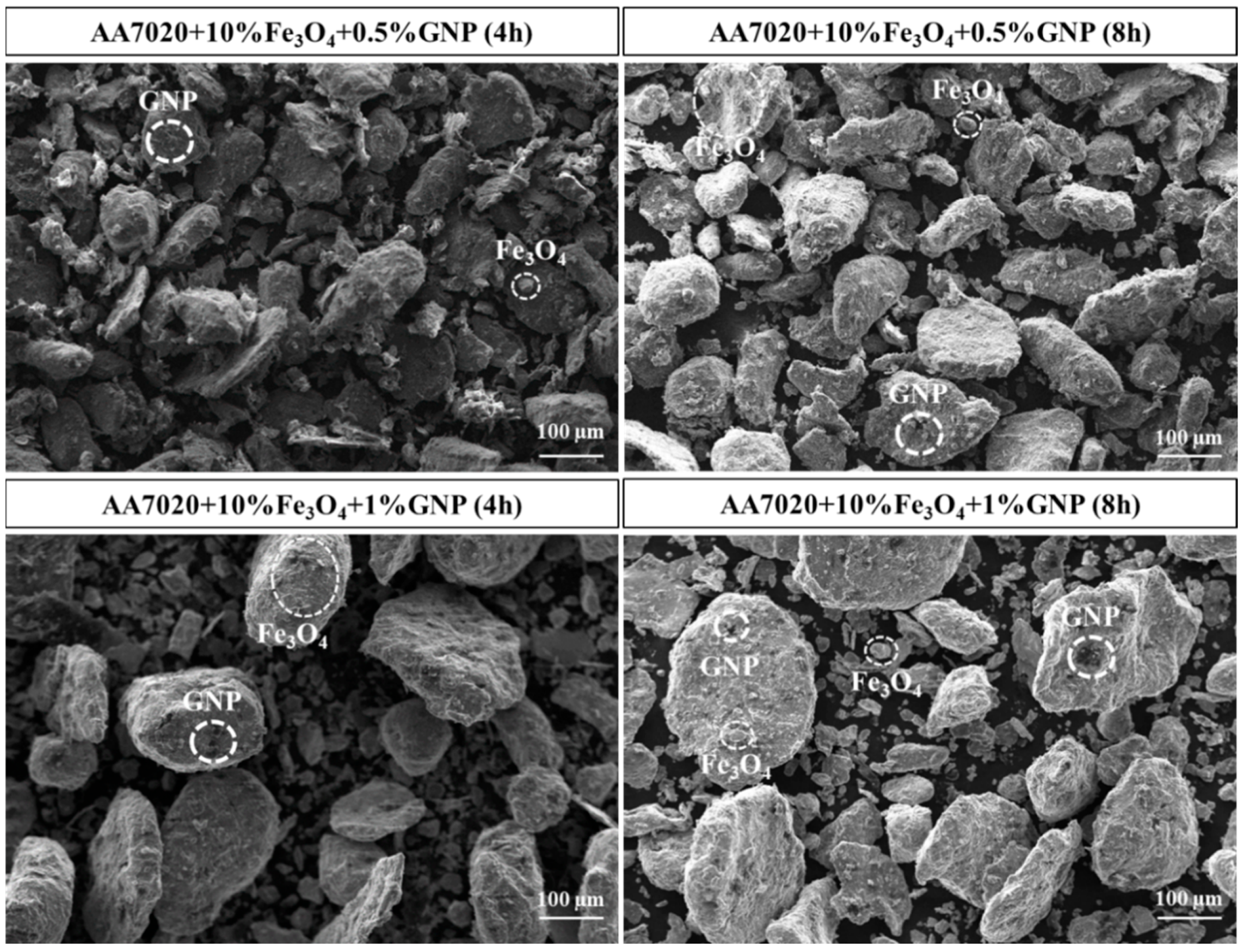
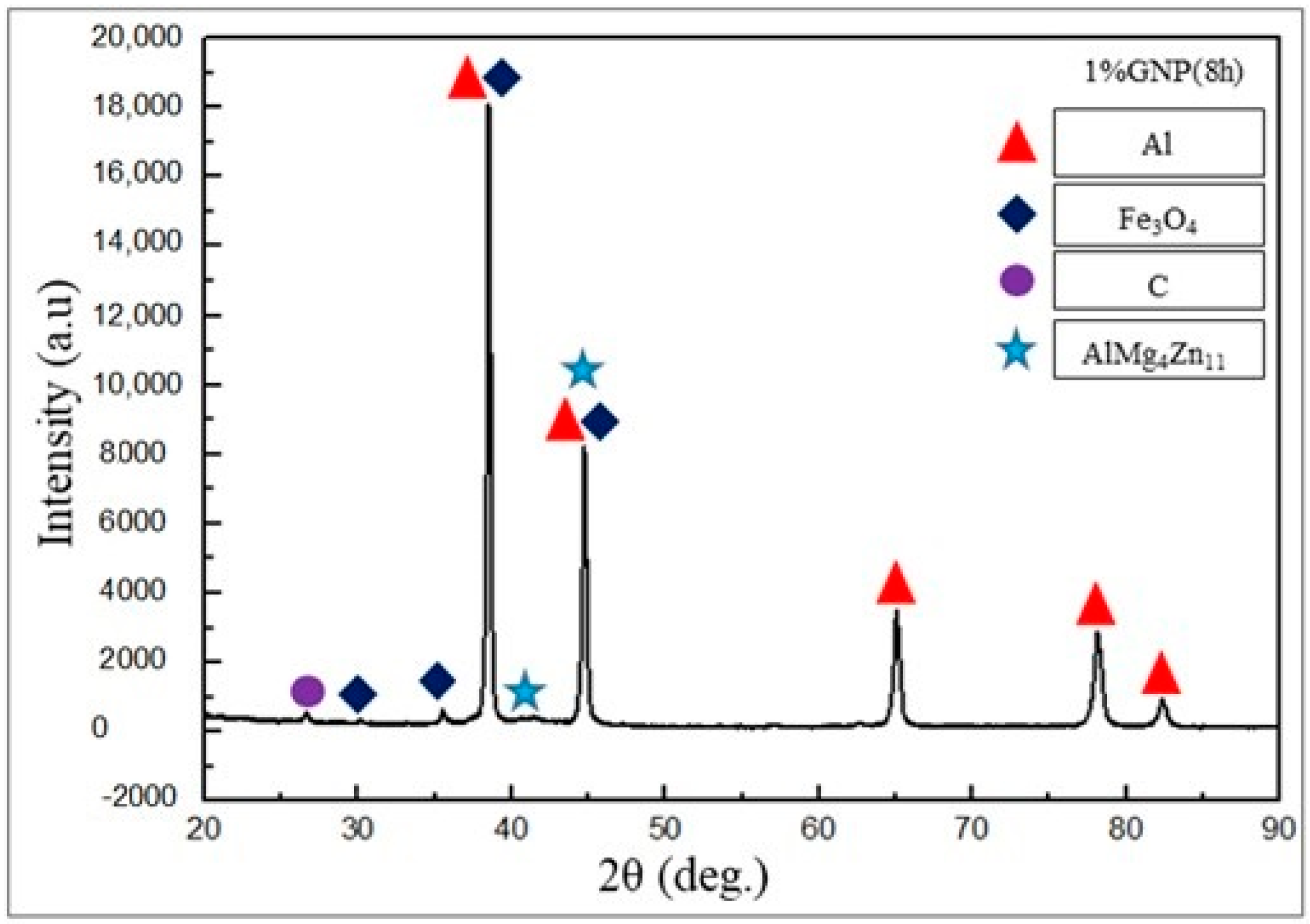
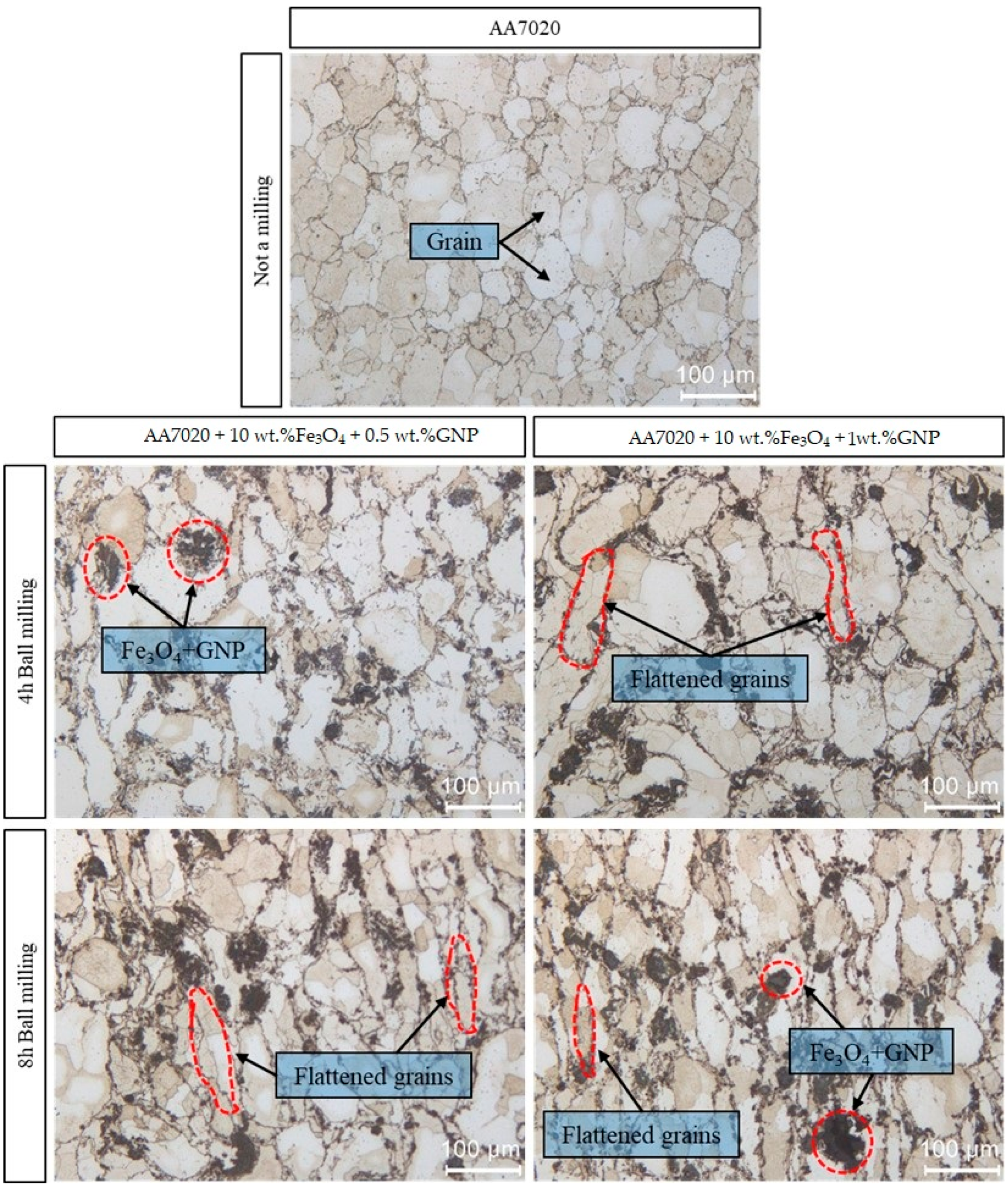

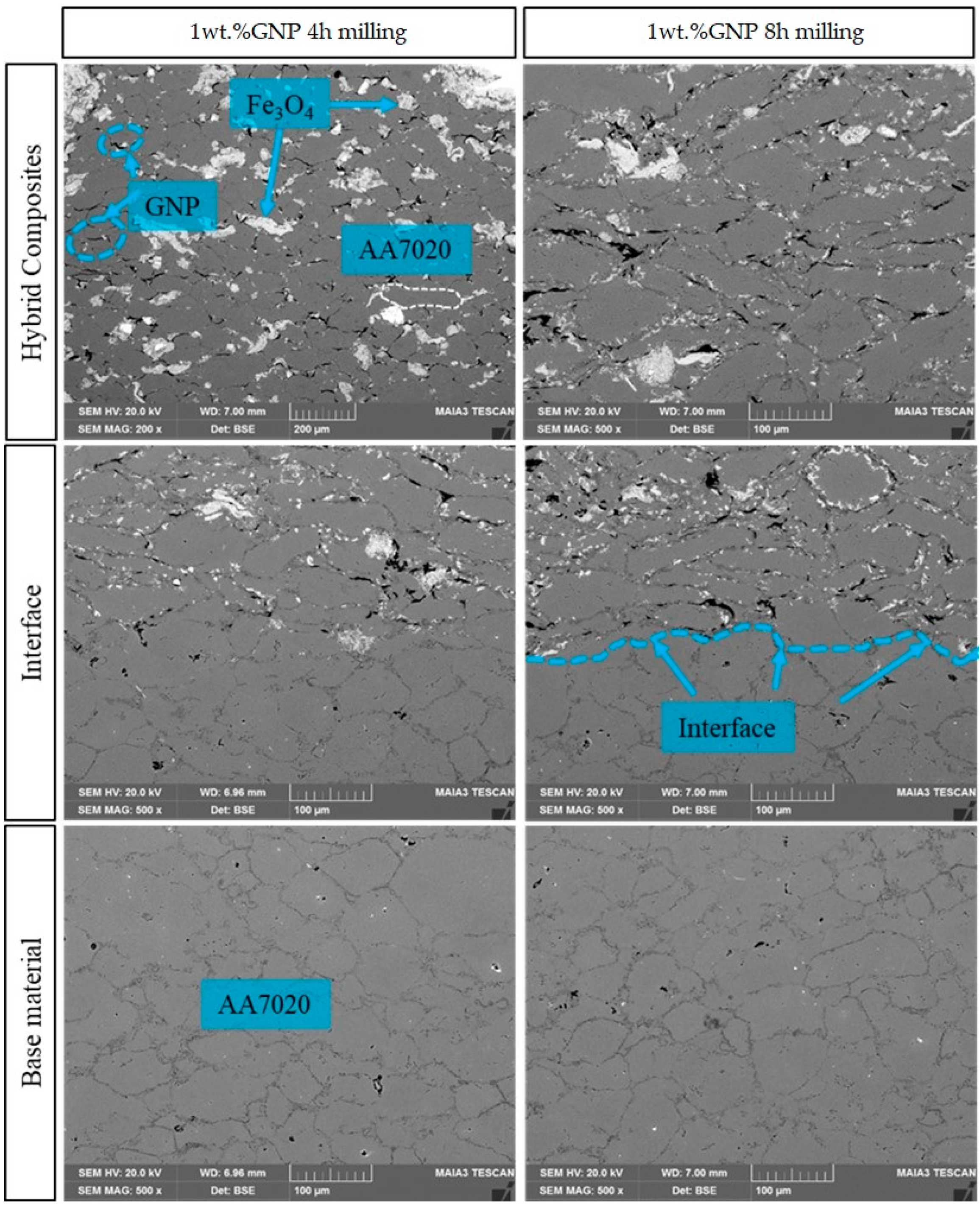
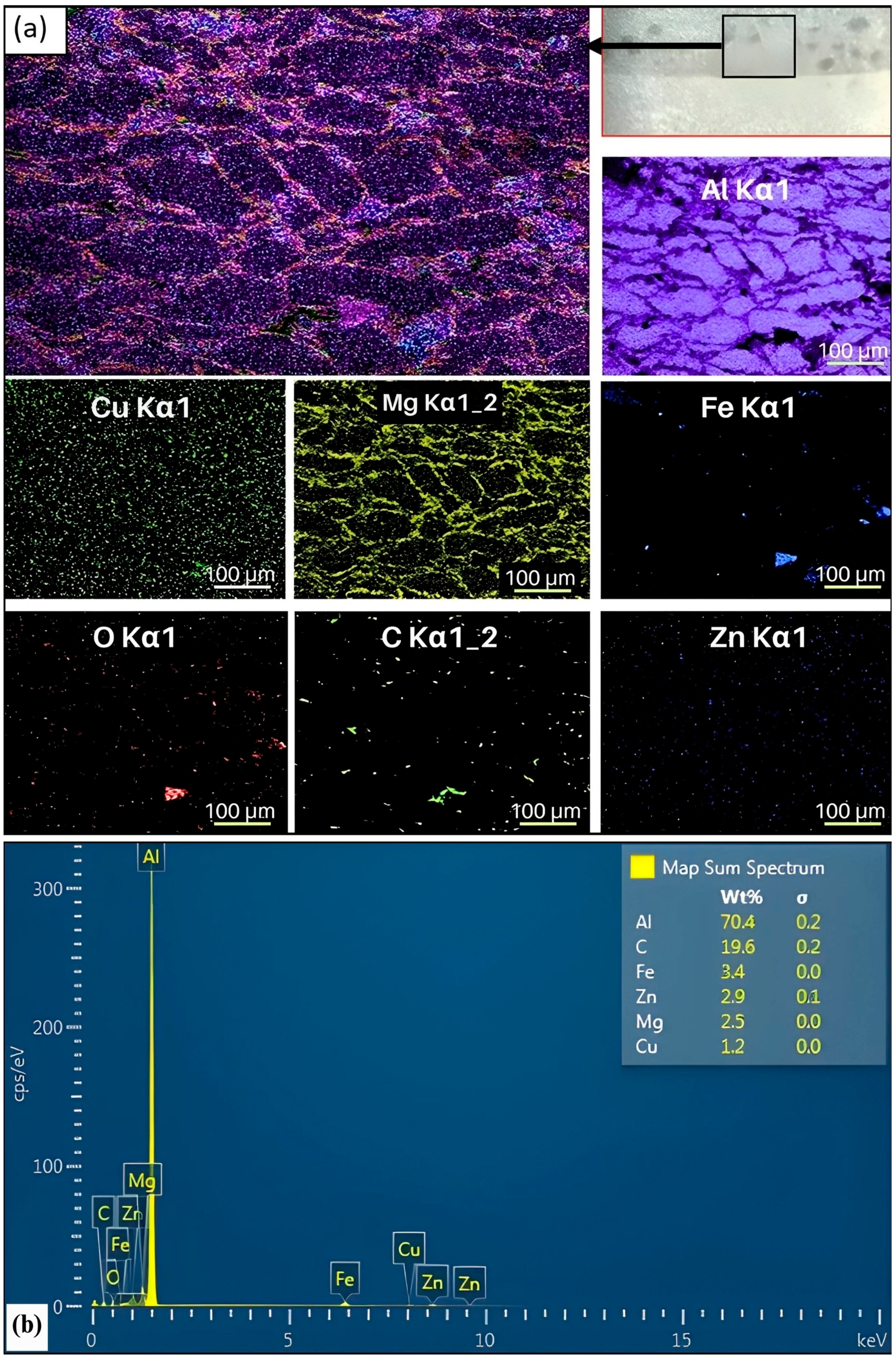

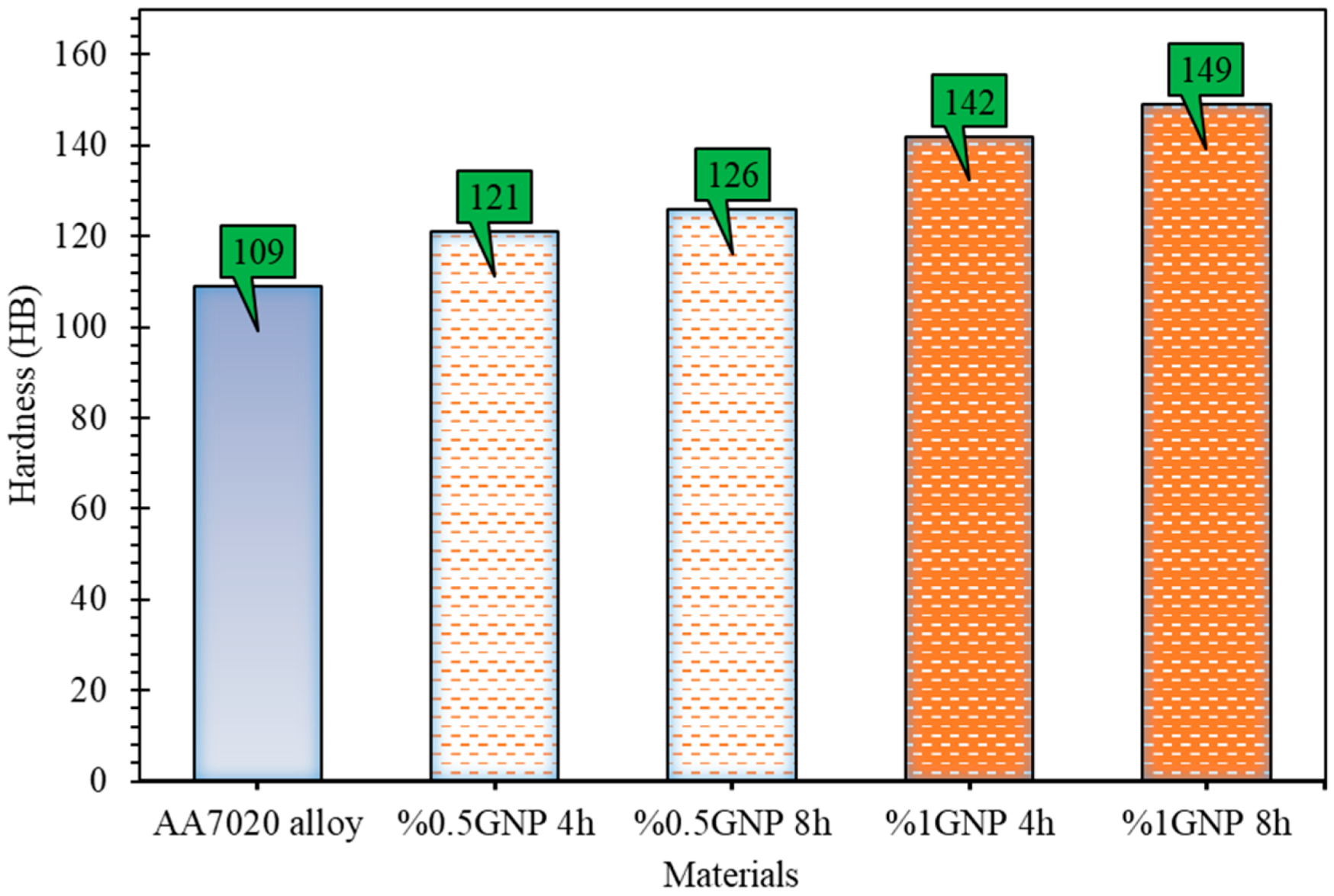
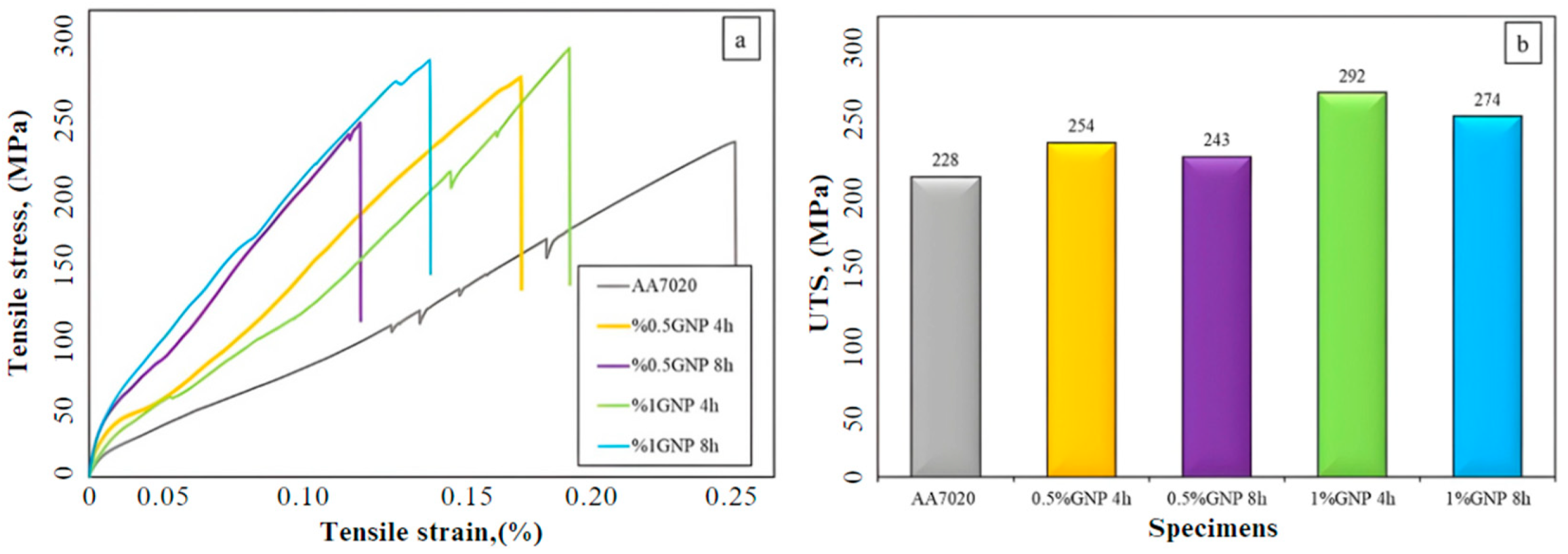


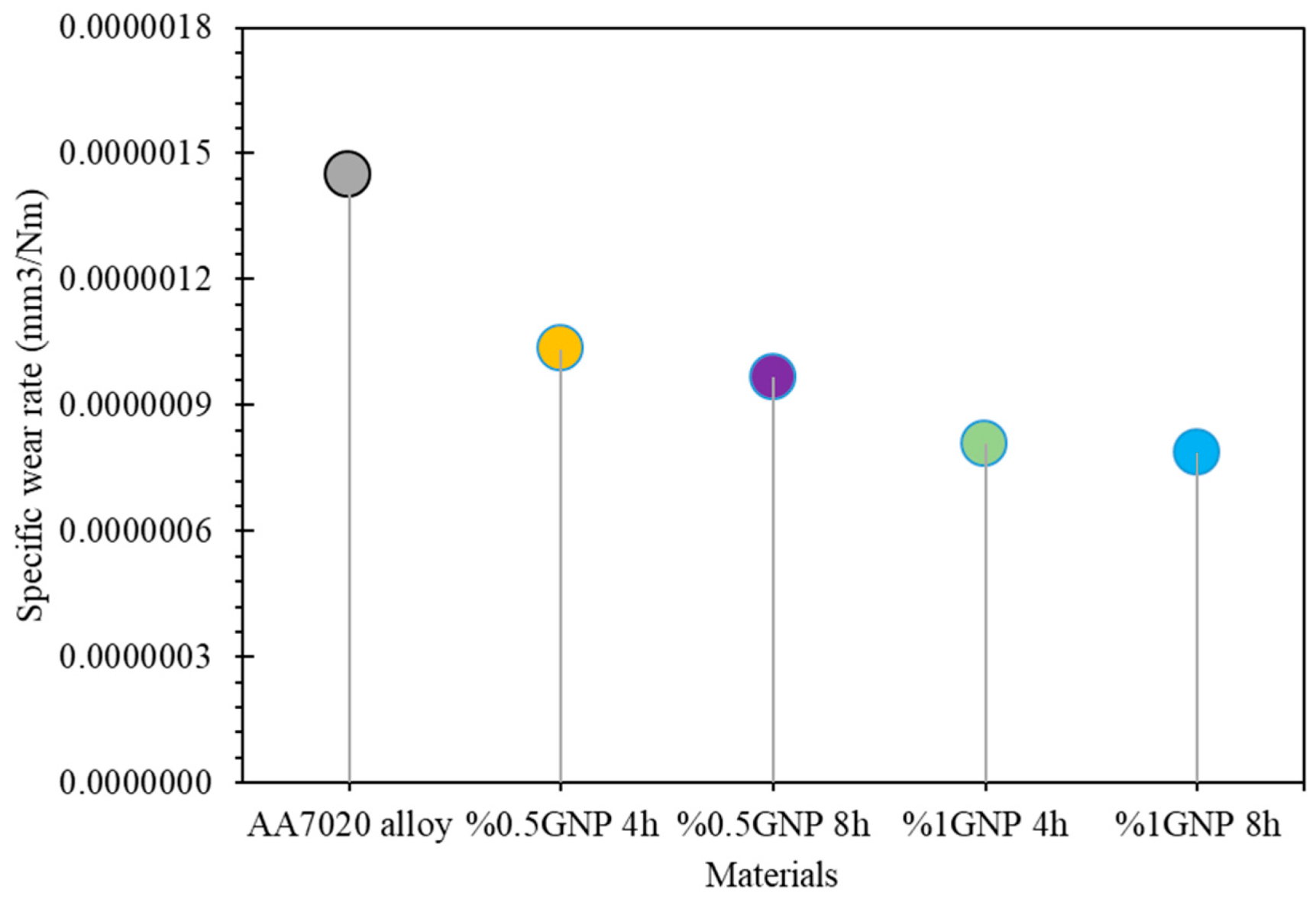

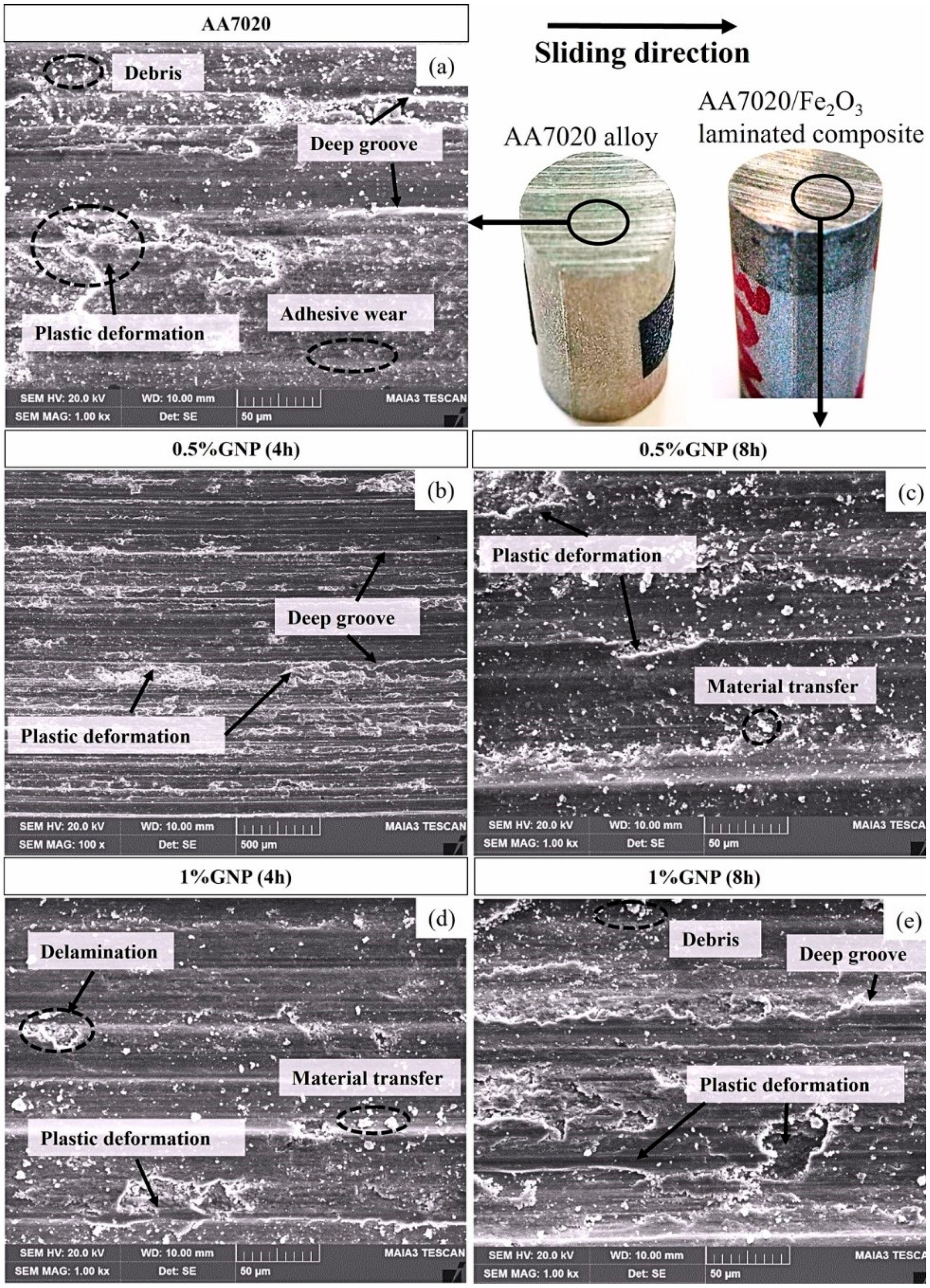
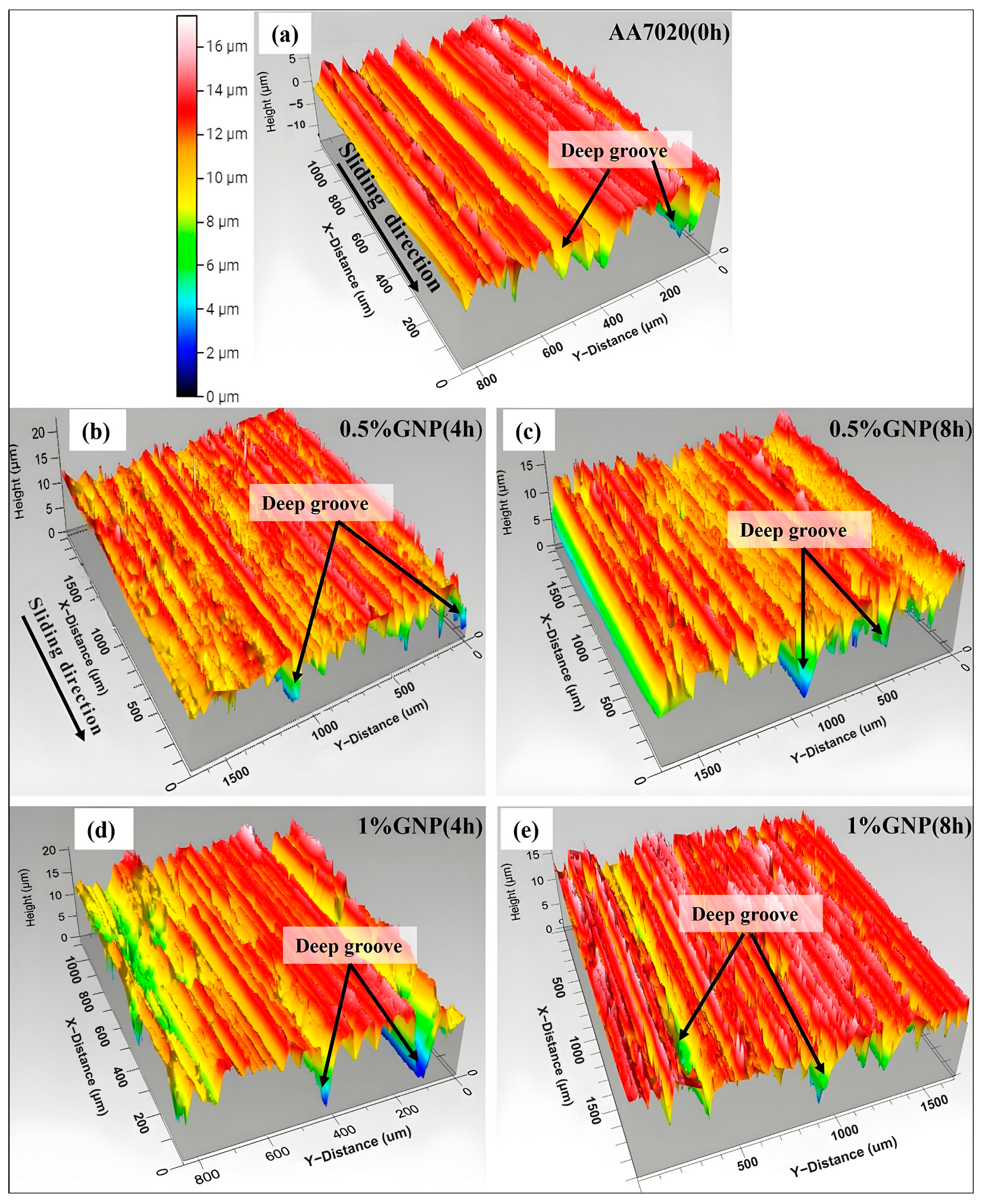

| Element | Zn | Mg | Ti | Zr | Fe | Si | Cu | Cr | Mn | Al |
|---|---|---|---|---|---|---|---|---|---|---|
| Content (%) | 4.5 | 1.40 | 0.25 | 0.070 | 0.4 | 0.35 | 0.2 | 0.10 | 0.040 | Balance |
Disclaimer/Publisher’s Note: The statements, opinions and data contained in all publications are solely those of the individual author(s) and contributor(s) and not of MDPI and/or the editor(s). MDPI and/or the editor(s) disclaim responsibility for any injury to people or property resulting from any ideas, methods, instructions or products referred to in the content. |
© 2024 by the authors. Licensee MDPI, Basel, Switzerland. This article is an open access article distributed under the terms and conditions of the Creative Commons Attribution (CC BY) license (https://creativecommons.org/licenses/by/4.0/).
Share and Cite
Taşcı, U.; Yılmaz, T.A.; Karakoç, H.; Karabulut, Ş. Enhancing Wear Resistance and Mechanical Behaviors of AA7020 Alloys Using Hybrid Fe3O4-GNP Reinforcement. Lubricants 2024, 12, 215. https://doi.org/10.3390/lubricants12060215
Taşcı U, Yılmaz TA, Karakoç H, Karabulut Ş. Enhancing Wear Resistance and Mechanical Behaviors of AA7020 Alloys Using Hybrid Fe3O4-GNP Reinforcement. Lubricants. 2024; 12(6):215. https://doi.org/10.3390/lubricants12060215
Chicago/Turabian StyleTaşcı, Ufuk, Taha Alper Yılmaz, Halil Karakoç, and Şener Karabulut. 2024. "Enhancing Wear Resistance and Mechanical Behaviors of AA7020 Alloys Using Hybrid Fe3O4-GNP Reinforcement" Lubricants 12, no. 6: 215. https://doi.org/10.3390/lubricants12060215





